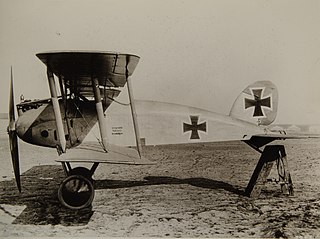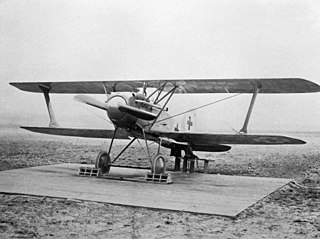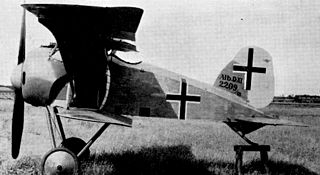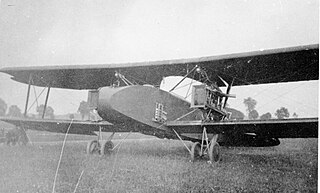| L 65 | |
|---|---|
 | |
| Memel A.F.G.1 | |
| Role | Reconnaissance aircraft |
| Manufacturer | Albatros Flugzeugwerke |
| First flight | 1925 |
| Number built | 2 |
The Albatros L 65 was a German two-seat reconnaissance fighter biplane first flown in 1925.
| L 65 | |
|---|---|
 | |
| Memel A.F.G.1 | |
| Role | Reconnaissance aircraft |
| Manufacturer | Albatros Flugzeugwerke |
| First flight | 1925 |
| Number built | 2 |
The Albatros L 65 was a German two-seat reconnaissance fighter biplane first flown in 1925.
Under the Treaty of Versailles, military aircraft production was restricted in Germany, so Albatros Flugzeugwerke established a subsidiary to build the L 65 in Lithuania. This company was named Allgemeine Flug-Gesellschaft (A.F.G.) Memel, hence the L 65 was also known as the Memel A.F.G.1 (Memel being the German name for the city of Klaipeda).
The L 65 had a single-bay, staggered biplane configuration and was constructed of wood with a plywood skin. The wings were braced by interplane I-struts of broad aerofoil cross-section. Two prototypes were built, the first powered by a 340 kW (450 hp) water-cooled 12-cylinder "broad-arrow" Napier Lion engine; the second had its first flight in 1926 and had a 421 kW (565 hp) version of the Lion. The second prototype underwent evaluation by the Reichswehr to equip the clandestine training school at Lipetsk, but the Heinkel HD 17 was selected instead and no further aircraft were produced.
General characteristics
Performance
Armament

The Gotha G.I was a heavy bomber used by the Luftstreitkräfte during World War I.

The AEG D.I was a biplane fighter of World War I. Three prototypes were ordered, but after the first two were involved in serious crashes, one of which killed flying ace Walter Höhndorf on September 5, 1917, development was cancelled. A triplane version was built as the Dr.I. The second and third prototypes differed little from the first except in detail.

The Albatros C.III was a German two-seat general-purpose biplane of World War I, built by Albatros Flugzeugwerke. The C.III was a refined version of the successful Albatros C.I and was eventually produced in greater numbers than any other C-type Albatros.

The Albatros C.I,, was the first of the successful C-series of two-seat general-purpose biplanes built by Albatros Flugzeugwerke during World War I. Based on the unarmed Albatros B.II, the C.I reversed the pilot and observer seating so that the observer occupied the rear cockpit which was fitted with a ring-mounted 7.92 mm (0.312 in) Parabellum MG14 machine gun.

The Arado Ar 65 was the single-seat biplane fighter successor to the Ar 64. Both looked very similar. The only major difference was the use of a 12-cylinder inline engine versus the Ar 64's radial. The wingspan was also increased.

The Albatros W.4 was a German floatplane derivative of the Albatros D.I fighter with new wing and tail surfaces of greater span than the D.I. One hundred eighteen examples were built between June 1916 and December 1917. The aircraft operated in the North Sea and Baltic theatres and later served as training aircraft.
Albatros D.VI was the designation given to a prototype single-seat twin-boom pusher biplane built in 1917 in Germany. It was armed with a fixed 7.92 mm (0.312 in) LMG 08/15 machine gun and a fixed 20 mm (0.787 in) Becker Type M2 cannon.

Albatros D.IX was a German prototype single-seat fighter built in early 1918. It differed from previous marks by using a simplified fuselage with a flat bottom and slab sides. The wings and tail were similar to those of the Albatros D.VII. Power was provided by a 130 kW (170 hp) Mercedes D.IIIa engine. The D.IX was armed with twin synchronised 7.92 mm (0.312 in) LMG 08/15 machine guns.

The Albatros D.X was a German prototype single-seat fighter biplane developed in 1918 in parallel with the Albatros D.IX.

The Albatros Dr.II was a German prototype single-seat fighter triplane, the sole example of which flew in the spring of 1918. It was similar in many respects to the D.X biplane, employing among other features the same 145 kW (195 hp) Benz Bz.IIIbo engine and twin 7.92 mm (.312 in) machine guns.

The Albatros D.XI was a German single-seat fighter biplane first flown in February 1918. It was the first Albatros fighter to use a rotary engine, in the form of the 120 kW (160 hp) Siemens-Halske Sh.III, and also featured a new wing construction with diagonal struts from the fuselage replacing traditional wire bracing.

The Albatros D.XII was a German single-seat fighter biplane first flown in March 1918. It was the last of the Albatros fighters completed and flown before the end of World War I and had the same slab-sided fuselage seen on the Albatros D.X.
The Albatros L 77v was a German tandem two-seat reconnaissance fighter biplane, four examples of which were built under license for Albatros Flugzeugwerke by Ernst Heinkel Flugzeugwerke in 1928. Based upon the L 76 Aeolus reconnaissance trainer, the aircraft was powered by a 450 kW (600 hp) BMW VI 5.5 water-cooled V12 engine.

The Avro 566 Avenger was a prototype British fighter of the 1920s, designed and built by Avro. It was a single-seat, single-engine biplane of wood and fabric construction. Although it was a streamlined and advanced design, it never entered production.

The Albatros G.III, was a German bomber aircraft development of World War I. It was a large, single-bay biplane of unequal span and unstaggered wings. Power was provided by two Benz Bz.IVa pusher engines installed in nacelles carried between the wings. An unusual feature of the design was that the lower wing was provided with cutouts for the propellers, allowing the engine nacelles to be mounted further forward than would have been otherwise possible. Few were built, these seeing service mostly on the Macedonian Front in 1917.

The Albatros L 75 Ass was a German trainer biplane of the 1920s. Of conventional configuration, it seated the pilot and instructor in separate, open cockpits. The wings were single-bay, equal-span, and had a slight stagger. Production continued after Albatros was absorbed by Focke-Wulf.

The Fokker D.II was a German fighter biplane of World War I. It was a single-seat fighter aircraft developed before the Fokker D.I. It was based on the M.17 prototype, with single-bay unstaggered wings and a larger fuselage and shorter span than production D.IIs. Using a 75 kW (100 hp) Oberursel U.I, the D.II was underpowered, though the single 7.92 mm (.312 in) lMG 08 machine gun was normal for 1916. The German Army purchased 177.

The Halberstadt D.I was a prototype fighter aircraft built in Germany in 1916 as a scaled down version of the firm's earlier B.II two seater. It was a conventional, two-bay biplane with staggered wings of nearly equal span and fixed, tailskid undercarriage. The engine was the same Mercedes D.I that was fitted to the B.II, and a single machine gun was fitted. Two prototypes were evaluated by the Idflieg, their performance being found inadequate. The modifications required to bring the aircraft up to an acceptable standard would result in the Halberstadt D.II later the same year.

The Heinkel HD 17 was a military reconnaissance aircraft produced in Germany in the late 1920s.

Polikarpov DI-1, also known as 2I-N1, Russian: Поликарпов ДИ-1 (2И-Н1), was a prototype Soviet two-seat fighter designed during the 1920s. The sole prototype built crashed on its ninth flight, due to manufacturing defects, and the program was cancelled.
| Wikimedia Commons has media related to Albatros L 65 . |